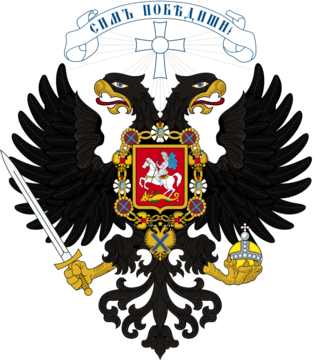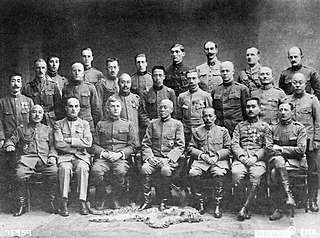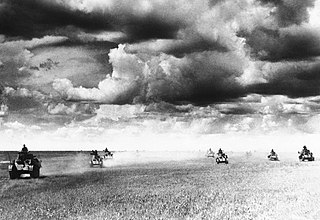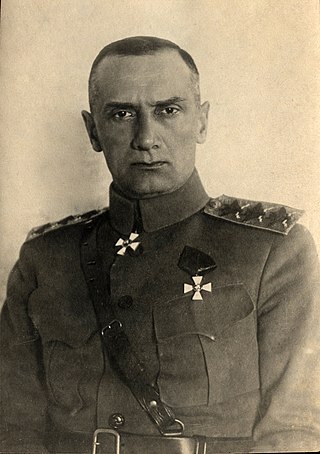
The Russian Civil War was a multi-party civil war in the former Russian Empire sparked by the overthrowing of the social-democratic Russian Provisional Government in the October Revolution, as many factions vied to determine Russia's political future. It resulted in the formation of the Russian Socialist Federative Soviet Republic and later the Soviet Union in most of its territory. Its finale marked the end of the Russian Revolution, which was one of the key events of the 20th century.

The Far Eastern Republic, sometimes called the Chita Republic, was a nominally independent state that existed from April 1920 to November 1922 in the easternmost part of the Russian Far East. Although nominally independent, it largely came under the control of the Russian Soviet Federative Socialist Republic (RSFSR), which envisaged it as a buffer state between the RSFSR and the territories occupied by Japan during the Russian Civil War of 1917–1922. Its first president was Alexander Krasnoshchyokov.

The White movement, also known as the Whites, was a loose confederation of anti-communist forces that fought the communist Bolsheviks, also known as the Reds, in the Russian Civil War (1917–1923) and that to a lesser extent continued operating as militarized associations of rebels both outside and within Russian borders in Siberia until roughly World War II (1939–1945). The movement's military arm was the White Army, also known as the White Guard or White Guardsmen.

The Czechoslovak Legion were volunteer armed forces comprised predominantly of Czechs and Slovaks fighting on the side of the Entente powers during World War I and the White Army during the Russian Civil War until November 1919. Their goal was to win the support of the Allied Powers for the independence of Lands of the Bohemian Crown from the Austrian Empire and of Slovak territories from the Kingdom of Hungary, which were then part of the Austro-Hungarian Empire. With the help of émigré intellectuals and politicians such as the Czech Tomáš Garrigue Masaryk and the Slovak Milan Rastislav Štefánik, they grew into a force over 100,000 strong.

Nikolai Nikolayevich Yudenich was a commander of the Russian Imperial Army during World War I. He was a leader of the anti-communist White movement in northwestern Russia during the Civil War.

Nikolai Robert Maximilian Freiherr von Ungern-Sternberg, often referred to as Roman von Ungern-Sternberg or Baron Ungern, was an anti-communist general in the Russian Civil War and then an independent warlord who intervened in Mongolia against China. A part of the Russian Empire's Baltic German minority, Ungern was an ultraconservative monarchist who aspired to restore the Russian monarchy after the 1917 Russian Revolutions and to revive the Mongol Empire under the rule of the Bogd Khan. His attraction to Vajrayana Buddhism and his eccentric, often violent, treatment of enemies and his own men earned him the sobriquet "the Mad Baron" or "the Bloody Baron".

Grigory Mikhaylovich Semyonov, or Semenov, was a Japanese-supported leader of the White movement in Transbaikal and beyond from December 1917 to November 1920, a lieutenant general, and the ataman of Baikal Cossacks (1919). He was the commander of the Far Eastern Army during the Russian Civil War. He was also a prominent figure in the White Terror. U.S. Army intelligence estimated that he was responsible for executing 30,000 people in one year.

The Allied intervention in the Russian Civil War consisted of a series of multi-national military expeditions that began in 1918. The initial impetus behind the interventions was to secure munitions and supply depots from falling into the German Empire's hands, particularly after the Bolsheviks signed the Treaty of Brest-Litovsk, and to rescue the Allied forces that had become trapped within Russia after the 1917 October Revolution. After the Armistice of 11 November 1918, the Allied plan changed to helping the White forces in the Russian Civil War. After the Whites collapsed, the Allies withdrew their forces from Russia by 1925.

The White Army or White Guard, also referred to as the Whites or White Guardsmen, was a common collective name for the armed formations of the White movement and anti-Bolshevik governments during the Russian Civil War. They fought against the Red Army of Soviet Russia.

The Russian Civil War spread to the east in May 1918, with a series of revolts along the route of the Trans-Siberian Railway, on the part of the Czechoslovak Legion and officers of the Russian Army. Provisional anti-Bolshevik local governments were formed in many parts of Siberia and other eastern regions during that summer. The Red Army mounted a counter-offensive in the autumn of 1918. Throughout the winter and spring of 1918/1919, the White Army had dominance over this front. In the summer of 1919, and from then onwards, the Red Army defeated the White commander Aleksandr Kolchak. The White Army collapsed in the East as well as on other fronts throughout the winter of 1919/1920. Smaller-scale conflicts in the region went on until as late as 1923.

The Siberian intervention or Siberian expedition of 1918–1922 was the dispatch of troops of the Entente powers to the Russian Maritime Provinces as part of a larger effort by the western powers, Japan, and China to support White Russian forces and the Czechoslovak Legion against Soviet Russia and its allies during the Russian Civil War. The Imperial Japanese Army continued to occupy Siberia even after other Allied forces withdrew in 1920.

The Soviet–Japanese border conflicts, also known as the Soviet-Japanese Border War, the First Soviet-Japanese War, the Russo-Mongolian-Japanese Border Wars or the Soviet-Mongolian-Japanese Border Wars, were a series of minor and major conflicts fought between the Soviet Union, Mongolia and Japan in Northeast Asia from 1932 to 1939.

The White movement in Transbaikal was a period of the confrontation between the Soviets and the Whites over dominance in Transbaikal from December 1917 to November 1920.

The revolt of the Czechoslovak Legion comprised the armed actions of the Czechoslovak Legion in the Russian Civil War against Bolshevik authorities, beginning in May 1918 and persisting through evacuation of the Legion from Siberia to Europe in 1920. The revolt, occurring in Volga, Ural, and Siberia regions along the Trans-Siberian Railway, was a reaction to a threat initiated by the Bolsheviks partly as a consequence of the Treaty of Brest-Litovsk. One major secondary consequence of victories by the Legion over the Bolsheviks was to catalyze anti-Bolshevik activity in Siberia, particularly of the Committee of Members of the Constituent Assembly, and to provide a major boost for the anti-Bolshevik or White forces, likely protracting the Russian Civil War.

The Russian Eastern Okraina was a local government that existed in the Russian Far East region in 1920 during the Russian Civil War of 1917–1923.

Alexander Vasilyevich Kolchak was a Russian admiral, military leader and polar explorer who held the title of Supreme Ruler of Russia from 1918 to 1920 during the Russian Civil War, though his actual control over Russian territory was limited. Previously, he served in the Imperial Russian Navy and fought in the Russo-Japanese War and World War I.

Regional government of Primorye Zemstvo was a local government that existed in the eastern part of Russia during the Russian Civil War between January 31, 1920 and October 28, 1920.

Vasily Yegorovich Flug was an Imperial Russian Army General of the Infantry. A career military officer, he served in the Boxer Rebellion, Russo-Japanese War, and World War I, before joining the White movement during the Russian Civil War. Like many other officers, he went into exile after the end of the Russian Civil War, initially moving to Yugoslavia. After World War II, Flug went to the United States, where he died.

Ivan Pavlovich Kalmykov, was an Ataman of the Ussuri Cossacks and General associated with the Anti-Bolshevik White Movement during the Russian Civil War.

The Russian State was a White Army anti-Bolshevik state proclaimed by the Act of the Ufa State Conference of September 23, 1918, “On the formation of the all-Russian supreme power” in the name of “restoring state unity and independence of Russia” affected by the revolutionary events of 1917, the October Revolution and the signing of the treaty of Brest-Litovsk with Germany.
















